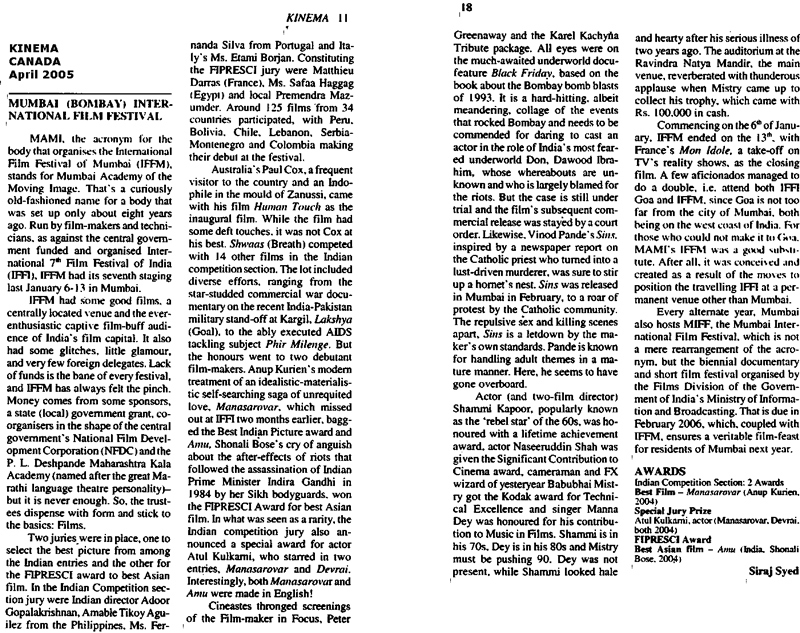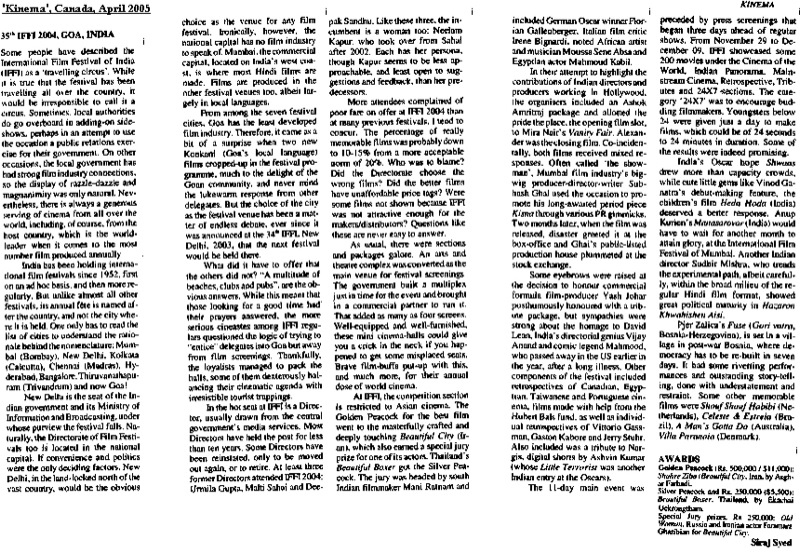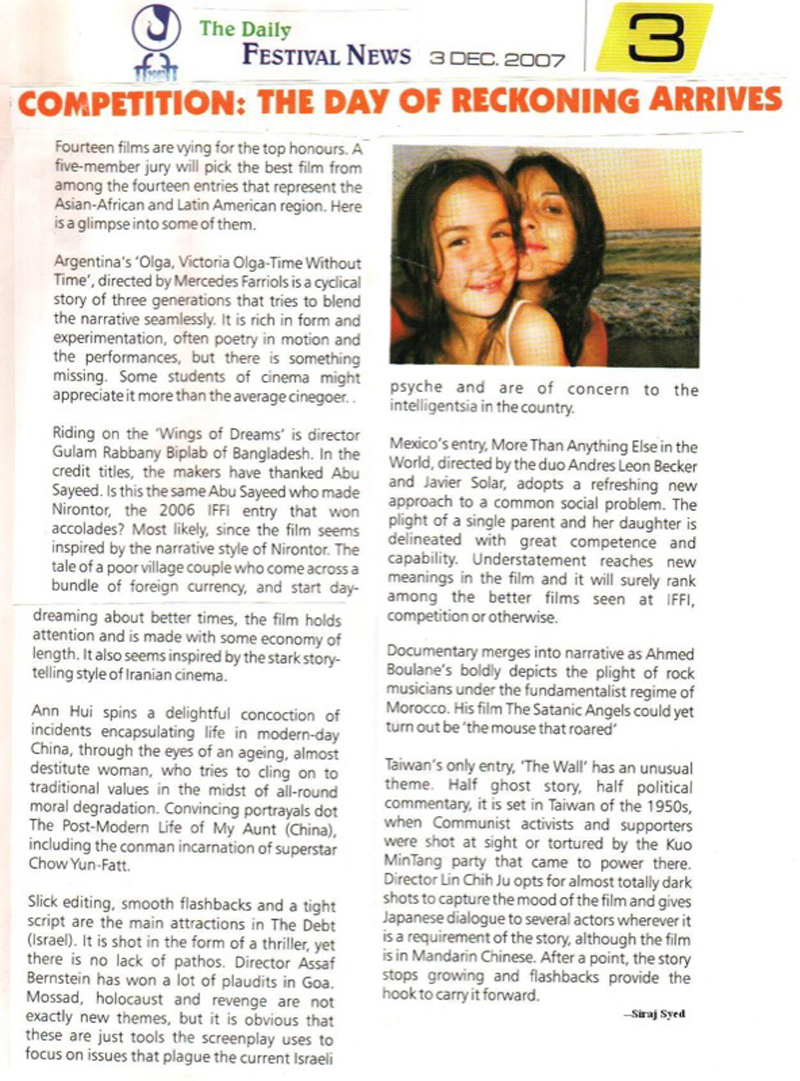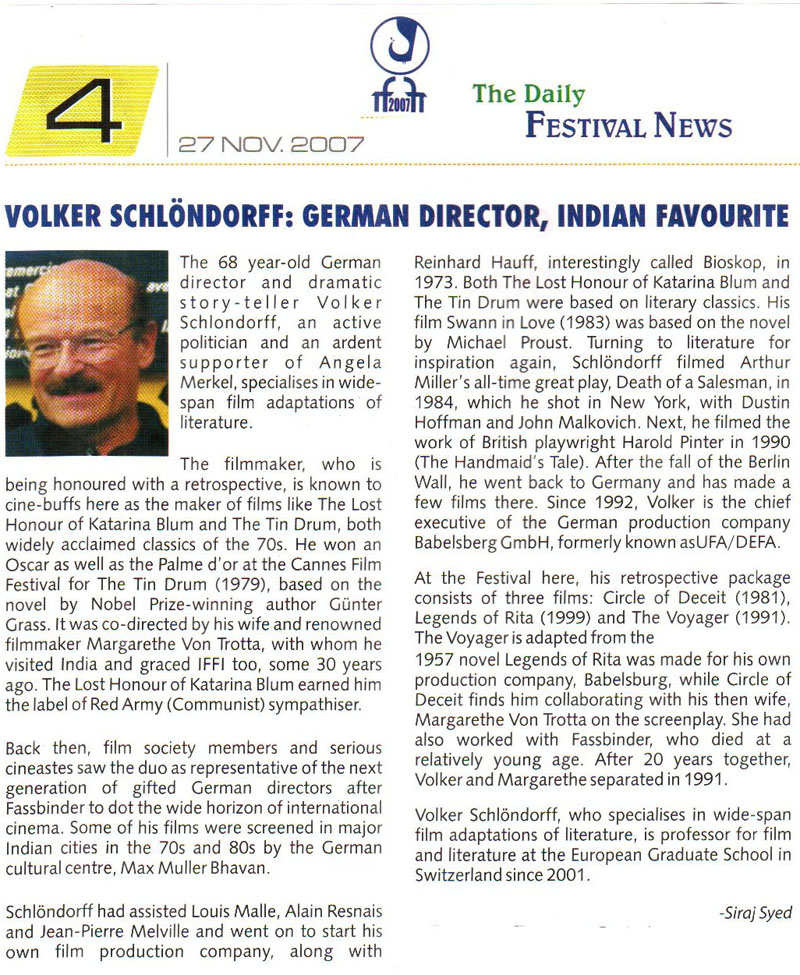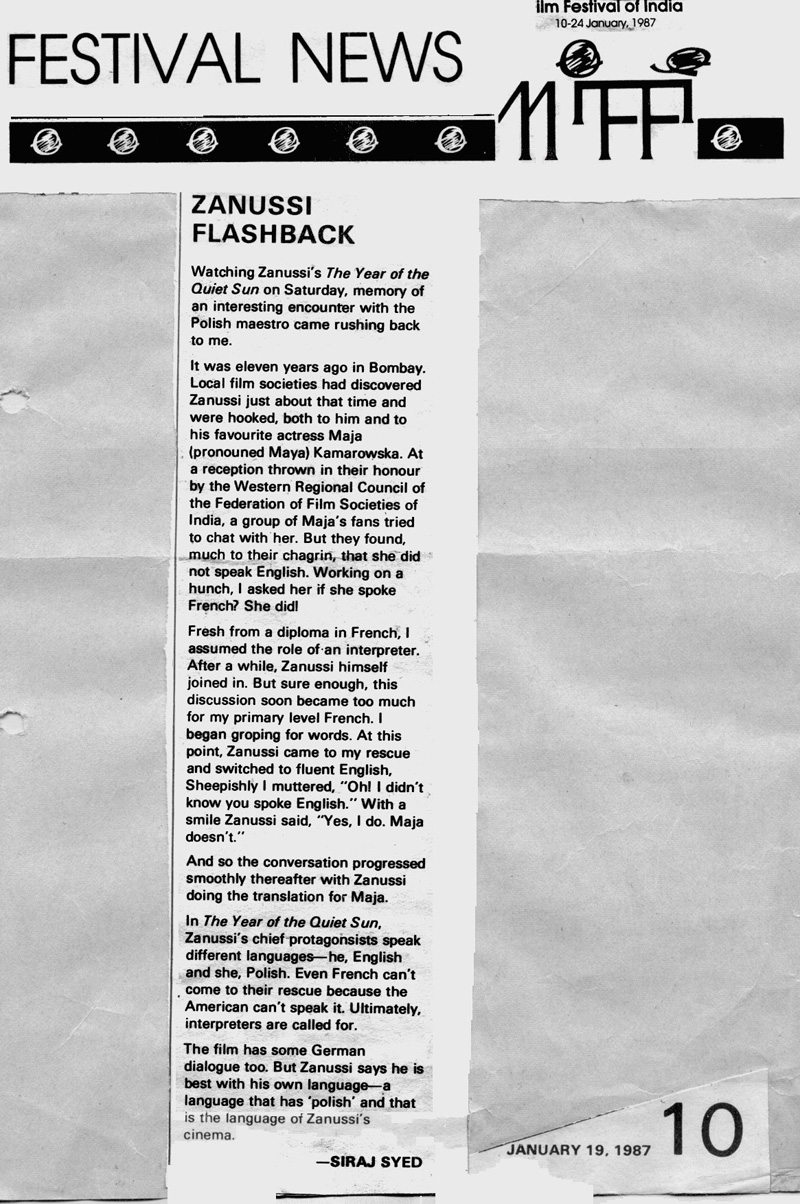|
|
||
|
Pro Tools
FILMFESTIVALS | 24/7 world wide coverageWelcome ! Enjoy the best of both worlds: Film & Festival News, exploring the best of the film festivals community. Launched in 1995, relentlessly connecting films to festivals, documenting and promoting festivals worldwide. Working on an upgrade soon. For collaboration, editorial contributions, or publicity, please send us an email here. User login |
Shashi Kapoors don’t die: Part I
Shashi Kapoors don’t die: Part I Showbiz is often cruel, usually ruthless. It takes so many factors to make it as an actor, luck or lineage included. Then, you need to stay on, weather flops and hits, and keep grabbing opportunities, in the hope that the next one will do it for you. Son of Prithviraj Kapoor, Balbir (Shashi) Raj Kapoor had done his bit of drama at his Papajee’s Prithvi Theatre, like his two older brothers (Ranbir) Raj Kapoor and Shamsher (Shammi) Raj Kapoor. They had even moved on—Raj was already a producer–director while in his early twenties while Shammi had got his act together. The most angrez (British) of the trio, he was in love with fellow actress Jennifer Kendal. Shashi looked the most chocolatey, sho... cute. Shammi as evolving the image of a lady-killer. Raj was incubating in his creative inner-self a socialistic portrayal of the deprived lot of the early 50s. Shashi was seen as a child in Aag, Sangram and Awara and was following the family tradition. His first films were released in 1961, two years after he had become a Dad to first-born Kunal. Char Diwari and Dharamputra. Actress Nanda, already a heroine of some standing, stood by him when most other leading ladies refused to work with this newcomer. Neither film served to establish him as an actor to contend with. In the following year, Prem Patra was a Bimal Roy production, and Shashi says he really learnt to face the camera under Bimalda’s direction. No commercial success, though. He got his first musical success with Mehndi Lagi Mere Haath, also a reasonable box office collection. I had yet to see a Shashi film till then, though I had been exposed to the films of the other two Kapoor brothers, and developed quite a fondness for Shammi.
Even before he was established as an actor in Hindustani films, Shashi made his international move, and appeared in the Ismail Merchant-James Ivory English film, Householder. But I first saw him in Yeh Dil Kisko Doon, a remake of a 1935 Vittorio De Sica starrer, Darò un milione--a cynical millionaire announces that he intends to disguise himself as a hobo and give a million Italian lire (one lakh rupees in the Hindi version) to anyone who dies him a favour. As a result, every bum around is given the royal treatment, on the off-chance that they could be the unseen, unphotographed millionaire. Five outstanding Mohammed Rafi playback songs, to which Shashi gave lip sync, remain hummable half a century later. Shashi was endearing, honest and so sincere. The film? Just about average. By now he had worked with a list of reputed directors, like Bimal Roy, Yash Chopra and Krishan Chopra. Roy’s banner sent for him again, in Benazir, though Roy thought it best to leave writing and directing to silent films’ fame, S. Khalil, who was also an actor. This was a second look at Shashi, for Bimal Roy. Tanuja and he made a comely couple, and the film had its moments. Not enough to catapult either, though. From the complex, populist plot of Yeh Dil Kisko Doon, here he was, in a Muslim social, and not in the lead. I found him unpretentious and easy. 1964 was easily the first big year in his short career so far. Of the four films he had bagged, one was Waqt and the other Jab Jab Phool Khile. Both jangled at the box-office. Shashi played the youngest of three brothers in the multi-starrer, Waqt, while he was cast as a Kashmiri boatman in JJPK. More than three decades later, JJPK was remade as Raja Hindustani. Not known for comedy, he was part of the rip-roaring Mahmood-Om Prakash rib-tickler, Pyar Kiye Jaa. Two solo hits were soon going to put him in the big league. Aamne Saamne and Haseena Maan Jayegi were murder mysteries of sorts, with superb music. Both turned out to be money-spinners. In quick succession, two more vehicles did it for Shashi: Sharmilee and Aa Gale Lag Jaa (1973), but I’ll stop at Sharmilee, 1971. The year meant so much to me. I had seen Sharmilee and liked Shashi in it. And was soon destined to meet him. Gifted with a keen sense of observation, I used to do mimicry at home and among friends. My brother, Riaz, who passed away in 2007, used to ask me to get on with it, whenever we had some visitors at home. Earliest impressions were of Biswajit in Bees Saal Baad (1962), though rumour has it that it all began with the song ‘Mohabbat men aese’ (Anarkali, 1953), at age 1 ½. Prithviraj, after Mughal-e-Azam (1960), had become everybody’s favourite while choosing an actor to imitate. By 1970, I had become a semi-professional compère-cum-mimic at events like musical shows, fund-raisers and annual get-togethers. At one such show, Shashi Kapoor was invited as the Chief Guest, and I was holding the microphone. He was to come later into the programme, and, in the meanwhile, we had songs and dances. Somebody needed time to set the stage, and I was asked to go in front of the curtain and keep the 1,000-strong audience engaged and entertained. I announced that I would now do an impression of Prithviraj Kapoor, and barely had I uttered the name, in walked KapoorSaahab’s son, Shashi, to thunderous applause. As he acknowledged the appreciation and settled down, almost right in front of me, in the first row, barely 10 feet away, I froze. How do you do a comic impression of an actor’s father, also an actor, to his face? How do you, at all of 19 years old, gather those guts? But the stage was now dead silent, as was the audience, and the show had to go on. I could not even change the item, having already announced it. Trusting my instinct and Shashi’s reputation, I told him what I was going to do, sought his permission, and was pleasantly surprised when he actually chuckled. What’s more, he clapped enthusiastically when the item was done. That is how I ‘met’ Shashi Kapoor for the first time. A while later, Shashi and his guests were invited on the stage for a felicitation ceremony and given mementoes. They included producer-director Subodh Mukerji. Subodhda (the da is a suffix of respect among Bengalis, and Mukerji was a Bengali) was the man who had made super-hits like Junglee, Shagird and Sharmilee (the latter two as producer). He gave me a whack on the back and said that I should come and see him for a likely acting assignment, in his next. Mr. Romeo. It did not quite happen that way. My route to the Subodh Mukerji Productions’ (SMP) office was circuitous. About 1 km towards the left from my newly acquired home in Bandra were the offices of Nasir Hussain Films (ground level) and Tahir Hussain Films (one floor above, in the same building). On the right, also about 1 km away, was the SMP office. Some incredible circumstances led to me being associated with the Hussain brothers’ films Anamika and Yaadon Ki Baaraat. They referred me to SMP, since Subodh Mukerji and the Hussain brothers were pals. And as destiny had ordained, I found myself acting in Mr. Romeo, directed by Subodh’s son Subhash, and starring a new girl Rinku Jaiswal, real name Rose Nathan, as the heroine. Subodhda had forgotten all about the whack on the back and the invitation to act, but when I reminded him, he retorted good-humouredly, “I hope I did not whack you too hard!”
Shashi, the Mr. Romeo, in bandages, horizontal, play-acting to win Rinku; vertically, friends play along, including one tall one You could call the Anamika role a cameo and the Yaadon Ki Baaraat footage landed on the editing floor. Mr. Romeo was my biggest exposure till that time. Of course, only an easily misled filmgoer would have felt at any stage of its production that this movie would be the next big thing. It was based on Neil Simon’s play (and Frank Sinatra starrer movie), Come Blow Your Horn, and I played one of the playboy hero’s hanger-on friends. We had several days of shooting, during which I got to know Shashi Kapoor quite well. And since some members of the direction department called him ShashiBaba, I too started using this moniker. Surprisingly, with his British wife, his Caucasian looking children, his work in several UK films, Baba did not seem out of place at all. Mr. Romeo also led to my second and last acting assignment with ShashiBaba in the lead. Koi Jeeta Koi Hara was an abandoned film, resurrected by the SMP camp, with Sameer Ganguly (Shagird, Sharmilee) directing. Of the original main cast, Shashi survived. Saira Banu came back from marriage induced retirement to complete the film. Romesh Sharma replaced Jeetendra. Being a crime drama cum romantic triangle, it had a number of villains, from the ‘President’ (Pinchoo Kapoor) to his assassin and successor, Ranjeet. Smaller fry in the syndicate included Narendranath, Viju Khote and Siraj Syed. Me? Gangster? Right. This one had slightly greater potential for a longer run, but it was mauled to shreds by the Government of India’s Censor Board, since by the time it was submitted for censoring, an Internal Emergency had been proclaimed in India, and no crime or violence or sex or liquor could be shown on screen, least of all a crime syndicate boss calling himself President. Koi Jeeta Koi Hara was mauled by the Board and blown to bits, till very little was left to see, and some of that had to be literally blown-up, to deliberately make it out of focus and thus illegible. That Sholay was also released during the emergency is another matter altogether. Over the two films together, I must have enjoyed Shashi’s company for several weeks. Besides, we met at several other venues on a variety of occasions, including the Hyderabad Filmotsav and the International Film Festival of India, Goa. Prithvi Theatre, the monument that Jennifer and Shashi built to the grand tradition of Prithviraj Kapoor, was his second home in the years after he gave up films altogether. We met there too, time and again. And, without meeting him, I was on the radio, lending my voice to the advertising campaigns of Shashi starrers, like Chor Machaye Shor, produced by my mentor and guru, Mr. Ameen Sayani. Of the only two films that I have sub-titled into English, one was New Delhi Times, a later day ‘art-house’ film, in which he played a newspaper editor. Friendly, warm, punctual, gifted with a dead-pan sense of humour, unassuming and with no star airs whatsoever—these words come pouring out when I remember Shashi. All of them are happy memories, except the occasions when I met after all the terrible things happened to him: the passing away of Jennifer, his over-indulgence in eating and drinking, his paralysis, his heart attack, his kidney failure. So much suffering for such a nice man! While suffering paralysis, and also short on memory, he recognised Simi, his co-star in Sidhhartha, a person with whom I share my birthday, and greeted her by name. I am, and never could be, anything more than a speck in his Heat and Dust career, so no such luck for me when I saw him seated in the Prithvi Cafe one evening. I never had to introduce myself to him, but on that day I did. He folded his hands and looked at me in the eye, without saying a word. As he held his hands together, and held the half vacant stare, tears rolled down my eyes, and I quickly turned away. Shashi Kapoor died in Mumbai on 04 December 2017, aged 79. Shashi Kapoor did not die! Shashi Kapoors don’t die... Soon: Part II 12.12.2017 | Siraj Syed's blog Cat. : Aa gale Lag Jaa Aag Aamne Saamne Anamika AnarKali Awara Bees Saal Baad Benazir Bimal Roy Biswajit Char Diwari Chor Machaye Shor Darò un milione Dharamputra Filmotsav Haseena Maan Jayegi Householder iffi Jab Jab Phool Khile Jeetendra Jennifer Kendal Junglee Koi Jeeta Koi Hara Krishan Chopra Mahmood Merchant Ivory Mr. Romeo Mughal-e-Azam Nasir Hussain New Delhi Times Om Prakash Pinchoo Kapoor playboy Prithvi Theatre Prithviraj Kapoor Raj Kapoor Raja Hindustani Romesh Sharma S. Khalil Sameer Ganguly Sangram Shagird Shammi Kapoor Sharmilee ShashiBaba Subhash Mukerji Tahir Hussain vittorio de sica Waqt Yaadon Ki Baaraat Yash Chopra Yeh Dil Kisko Doon PEOPLE
|
LinksThe Bulletin Board > The Bulletin Board Blog Following News Interview with IFTA Chairman (AFM)
Interview with Cannes Marche du Film Director
Filmfestivals.com dailies live coverage from > Live from India
Useful links for the indies: > Big files transfer
+ SUBSCRIBE to the weekly Newsletter Deals+ Special offers and discounts from filmfestivals.com Selected fun offers
> Bonus Casino
User imagesAbout Siraj Syed Syed Siraj Syed Siraj (Siraj Associates) Siraj Syed is a film-critic since 1970 and a Former President of the Freelance Film Journalists' Combine of India.He is the India Correspondent of FilmFestivals.com and a member of FIPRESCI, the international Federation of Film Critics, Munich, GermanySiraj Syed has contributed over 1,015 articles on cinema, international film festivals, conventions, exhibitions, etc., most recently, at IFFI (Goa), MIFF (Mumbai), MFF/MAMI (Mumbai) and CommunicAsia (Singapore). He often edits film festival daily bulletins.He is also an actor and a dubbing artiste. Further, he has been teaching media, acting and dubbing at over 30 institutes in India and Singapore, since 1984.View my profile Send me a message The EditorUser contributions |


















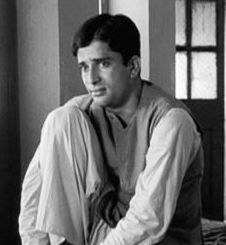 Householder
Householder

